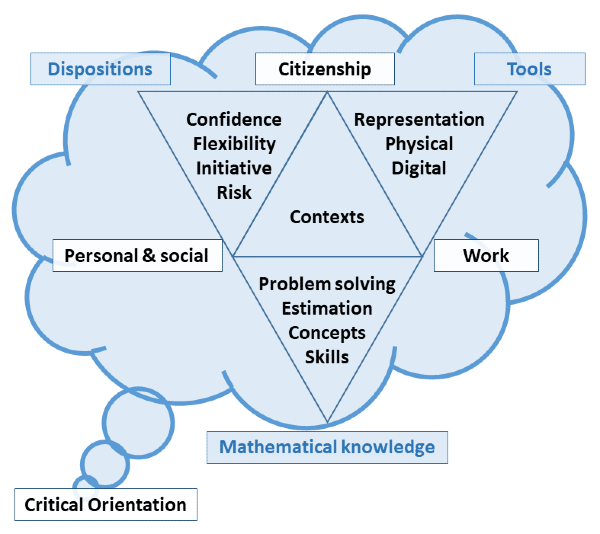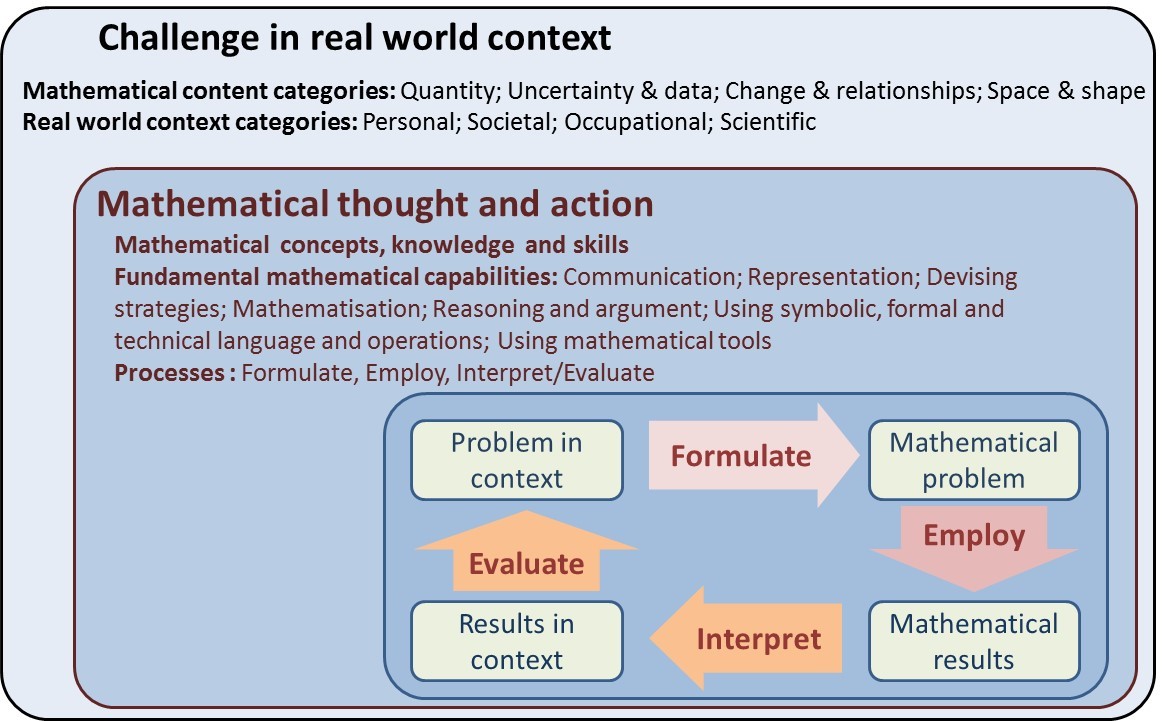There are now a number of existing frameworks or models for numeracy that can be utilised to frame what we need to do in order to improve and enhance our teaching and learning of numeracy and maths.
Evidence base
Based on, and as a part of, the research into numeracy and mathematical literacy and the increasing demands for higher levels of numeracy and mathematics in the 21st century summarised above, there are now a number of existing frameworks or models for numeracy that can be utilised to frame what we need to do in order to improve and enhance our teaching and learning of numeracy and maths.
For example, a significant Australian model is illustrated in Figure 1. below. This model incorporates four dimensions of settings/contexts, mathematical knowledge, tools, and dispositions that are embedded in a critical orientation to using mathematics. These dimensions are described more fully in other publications (e.g., Geiger et al. 2015; Goos et al, 2014).
 Figure 1. Numeracy in the 21st century (Goos et al, 2014; Geiger et al. 2015)
Figure 1. Numeracy in the 21st century (Goos et al, 2014; Geiger et al. 2015)Figure 1: Long description
This diagram critically orients the viewer into several elements related to numeracy knowledge and behaviours. It depicts a larger upturned equilateral triangle, resting on its apex.
The term, mathematical knowledge is noted on the bottom vertex (apex) of the triangle, the term dispositions on the left vertex of the triangle, and the term tools on the right vertex of the triangle.
The term ‘Personal and Social’ is noted on the left side of this triangle, the term ‘Work’ on the right-hand side and ‘Citizenship’ is noted on the base of the triangle.
This larger equilateral triangle is divided into four smaller, equilateral triangles of equal shape and size. The lower triangle is upturned and contains the terms ‘Problem Solving, Estimation, Concepts and Skills. Above this triangle is a layer of three triangles. The left-hand triangle is upturned and contains the words ‘Confidence, Flexibility, Initiative and Risk’. Adjoining this triangle is another inverted equivalent sized triangle that contains the term ‘Contexts’. On its right is an upturned triangle contains the terms ‘Representational, Physical and Digital’.
The model views numeracy as having the capacity to use mathematical knowledge in a range of contexts, both within schools and beyond school settings:
- to have positive dispositions to maths and the confidence, willingness and preparedness to flexibly use mathematical approaches and knowledge to engage with life-related tasks
- to use physical materials and tools (models, measuring instruments), representations (symbol systems, graphs, maps, diagrams, drawings, tables) and digital tools (computers, software, calculators, internet) to mediate and shape the mathematical actions and thinking.
And the model suggests there is a need for a critical orientation that enables the use of mathematical information to make decisions and judgements, and to argue and challenge.
PISA mathematical literacy frames its model along similar lines, but is based more explicitly on a real-world, problem solving cycle. One core idea behind the PISA description is that when individuals use mathematics and mathematical tools to solve problems set in a real world situation, they work their way through a series of stages as depicted in Figure 2 below.
The formulating, employing, interpreting, and evaluating processes are key components of the cycle. These processes are shown as drawing on the problem solver's fundamental mathematical capabilities and knowledge across four maths content areas. The PISA definition and model covers many of the same elements as shown in the Goos et al model above, including the use of tools and different representations.
 Figure 2. Representation of key elements of the PISA mathematics framework (from OECD, 2019)
Figure 2. Representation of key elements of the PISA mathematics framework (from OECD, 2019)
These two models serve to highlight the complex nature of numeracy, and the broad range of factors and skills that need to be addressed and taken on board when supporting students to become numerate.
They are also consistent with the earlier AAMT list of maths skills required of workers, which required workers to have the ability to recognise and identify how and when mathematics is used in the workplace; have an understanding of mathematical concepts, procedures and skills, and have an understanding of the strategic processes they should be able to use in using and applying mathematics.
Being numerate therefore involves more than just mastering basic mathematics in a school classroom, because numeracy connects the mathematics learned at school with out of-school situations that additionally require problem solving, critical judgement, and making sense of the non-mathematical context.
But why do we need to address this issue of numeracy and the demands for higher levels of numeracy and maths? Aren't Australian school children sufficiently skilled in numeracy and mathematics?
What is research showing about Australian's skills and abilities in numeracy?
Australian 15 year-old students' performance in the Programme for International Student Assessment (PISA) of mathematical literacy has declined since 2003, and there are persistent equity gaps in the performance of students from disadvantaged groups (e.g., see Thomson et al, 2019).
The PISA results also show clearly that the same students are relatively much stronger in reading (literacy) than in numeracy, and this is reinforced by analysing Australia's performance in the adult equivalent to PISA, the Programme for International Assessment of Adult Competencies (PIAAC), which was most recently conducted in Australia in 2011–2012 (e.g., see Turner & Tout, 2016). The data from both PISA and PIAAC indicate clearly that Australian students and adults perform significantly better in reading literacy than in numeracy.
This evidence indicates we need to do more about improving the ability of our students to be able to understand, use and apply mathematics in their lives—to become more numerate.
Taken together, although Australia’s average results are not poor, the challenges presented by adults with low basic skills may lead to Australia being left behind in terms of innovation and economic growth by countries that have been more successfully investing in the skills of all their people. (OECD, 2017, p. 9)
The OECD released a targeted country report on Australia's performance in PIAAC, Building Skills for All in Australia: Policy Insights from the Survey of Adult Skills (OECD, 2017). This closer examination of Australia's performance revealed six key challenges, with the first three explicitly focused on numeracy:
- numeracy represents a particular challenge in Australia
- signs of poor numeracy performance can be traced back to initial schooling
- women have weaker numeracy skills than men. (OECD, 2017, p. 9)
The other three challenges named referred to both literacy and numeracy issues that are seen as challenges for Australia. This report adds to the evidence that in Australia we need to better address the numeracy competence of our young people (and our adults).
For women, while the impact of low literacy and low numeracy is substantial, low numeracy has the greatest negative effect, even when it is combined with competent literacy. … Poor numeracy skills make it difficult to function effectively in all areas of modern life, particularly for women. (Bynner & Parsons, 2005, p. 7)
Does it matter?
Investing in the mathematical literacy/numeracy skills of young people and adults has significant benefits—for the individual, for society and for the economy and in some areas this is more significant for numeracy (e.g., see Bynner & Parsons, 2005; OECD 2017 & 2019; Turner & Tout, 2016).
Longitudinal research from the UK indicates that, especially for women, low numeracy has a greater negative effect even than low literacy.
For women, while the impact of low literacy and low numeracy is substantial, low numeracy has the greatest negative effect, even when it is combined with competent literacy. … Poor numeracy skills make it difficult to function effectively in all areas of modern life, particularly for women. (Bynner & Parsons, 2005, p. 7)